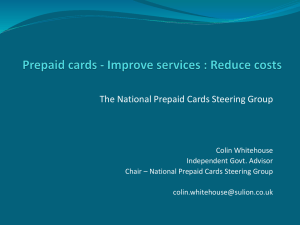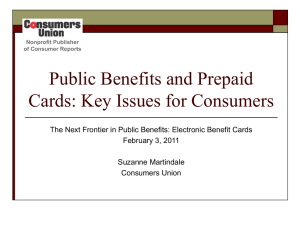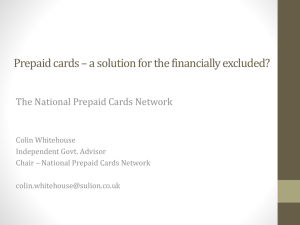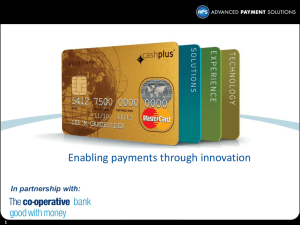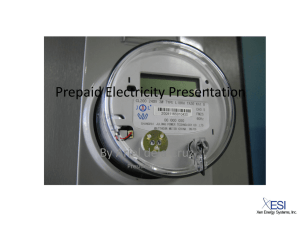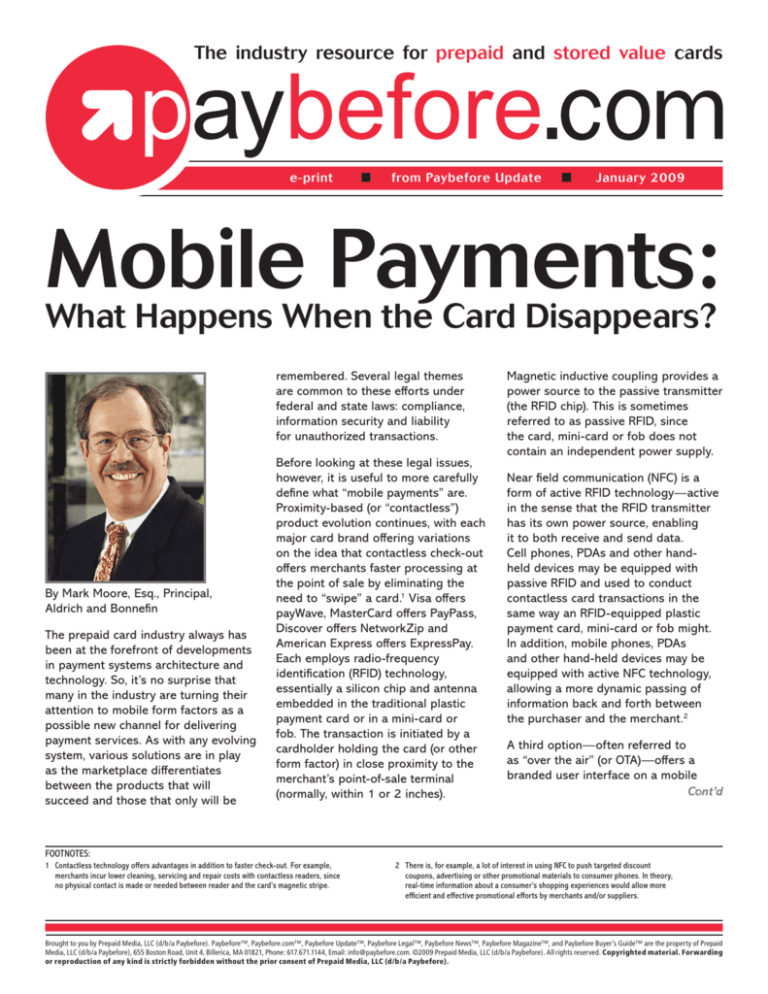
The industry resource for prepaid and stored value cards
e-print
from Paybefore Update
January 2009
Mobile
Payments:
What Happens When the Card Disappears?
remembered. Several legal themes
are common to these efforts under
federal and state laws: compliance,
information security and liability
for unauthorized transactions.
By Mark Moore, Esq., Principal,
Aldrich and Bonnefin
The prepaid card industry always has
been at the forefront of developments
in payment systems architecture and
technology. So, it’s no surprise that
many in the industry are turning their
attention to mobile form factors as a
possible new channel for delivering
payment services. As with any evolving
system, various solutions are in play
as the marketplace differentiates
between the products that will
succeed and those that only will be
Before looking at these legal issues,
however, it is useful to more carefully
define what “mobile payments” are.
Proximity-based (or “contactless”)
product evolution continues, with each
major card brand offering variations
on the idea that contactless check-out
offers merchants faster processing at
the point of sale by eliminating the
need to “swipe” a card.1 Visa offers
payWave, MasterCard offers PayPass,
Discover offers NetworkZip and
American Express offers ExpressPay.
Each employs radio-frequency
identification (RFID) technology,
essentially a silicon chip and antenna
embedded in the traditional plastic
payment card or in a mini-card or
fob. The transaction is initiated by a
cardholder holding the card (or other
form factor) in close proximity to the
merchant’s point-of-sale terminal
(normally, within 1 or 2 inches).
Magnetic inductive coupling provides a
power source to the passive transmitter
(the RFID chip). This is sometimes
referred to as passive RFID, since
the card, mini-card or fob does not
contain an independent power supply.
Near field communication (NFC) is a
form of active RFID technology—active
in the sense that the RFID transmitter
has its own power source, enabling
it to both receive and send data.
Cell phones, PDAs and other handheld devices may be equipped with
passive RFID and used to conduct
contactless card transactions in the
same way an RFID-equipped plastic
payment card, mini-card or fob might.
In addition, mobile phones, PDAs
and other hand-held devices may be
equipped with active NFC technology,
allowing a more dynamic passing of
information back and forth between
the purchaser and the merchant.2
A third option—often referred to
as “over the air” (or OTA)—offers a
branded user interface on a mobile
C nt’d
FOOTNOTES:
1 Contactless technology offers advantages in addition to faster check-out. For example,
merchants incur lower cleaning, servicing and repair costs with contactless readers, since
no physical contact is made or needed between reader and the card’s magnetic stripe.
2 There is, for example, a lot of interest in using NFC to push targeted discount
coupons, advertising or other promotional materials to consumer phones. In theory,
real-time information about a consumer’s shopping experiences would allow more
efficient and effective promotional efforts by merchants and/or suppliers.
Brought to you by Prepaid Media, LLC (d/b/a Paybefore). Paybefore™, Paybefore.com™, Paybefore Update™, Paybefore Legal™, Paybefore News™, Paybefore Magazine™, and Paybefore Buyer’s Guide™ are the property of Prepaid
Media, LLC (d/b/a Paybefore), 655 Boston Road, Unit 4, Billerica, MA 01821, Phone: 617.671.1144, Email: info@paybefore.com. ©2009 Prepaid Media, LLC (d/b/a Paybefore). All rights reserved. Copyrighted material. Forwarding
or reproduction of any kind is strictly forbidden without the prior consent of Prepaid Media, LLC (d/b/a Paybefore).
Mobile Payments: What Happens When the Card Disappears?
January 2009, By Mark Moore, Esq., Principal, Aldrich and Bonnefin
phone or other device. OTA paymentrelated software can be loaded
before or after a phone is sold. With
OTA, payment information may be
processed through a card brand (under
payWave or PayPass, for example)
or may be routed through another
payment system such as a money
transmitter. For example, Obopay
offers mobile phone software coupled
with its money transmitter function
to accomplish P2P (here, “phone
to phone” as much as “person to
person”) and supplements that with a
MasterCard function to allow transfers
to and from cards (as a payment
destination or as a funding source).
In some cases, mobile payments
involve the use of a mobile network
telecommunications carrier or
operator. Whether NFC or OTA,
with a mobile phone also comes
added functionality. Web-application
protocol (WAP) may be used with
a properly equipped mobile phone
to supplement its use as an access
device for payment services, allowing
fuller integration with, for example,
financial tracking and recordkeeping
software. Some posit that a “killer
application” might consist of a mobile
phone that initiates payments at
the point of sale, tracks balances
and updates personal or business
financial software—all in real time.
So what are the compliance,
information security and liability
issues in this brave new world?
Page 2
Compliance
Closed- and open-loop prepaid “card”
programs can be moved to mobile
delivery systems. As a general matter,
the compliance impact on issuers
(that is, the banks holding customer
accounts or operating subaccount
programs for an ISO/TPS program
manager) remains much the same
even with the transition from a more
traditional plastic card to a contactless
or other mobile channel. This generally
also would be true as to the compliance
issues faced by the processors,
program managers and merchants that
might be involved in a mobile channel.
Looking at network branded
prepaid cards as the underlying
product, compliance begins
with federal and state laws, and
includes card brand rules.
Federal Rules
Regulation E applies to payroll cards
but does not apply to other prepaid
accounts.3 Where Regulation E applies,
initial and periodic disclosures are
mandated. In addition, billing rights
notices must be refreshed annually or
included with periodic statements in
an abbreviated form. Use of a mobile
channel would not alter these rules,
although the content of one or more
of the disclosures might change. For
example, initial disclosures of types
of transfers and limitations under
Regulation E Section 205.7(b)(4) would
need to include some description of
the mobile application and its limits
(if any), particularly where these
might differ from more traditional
card programs. General contract law
principals lead to the same concern.
It would, for example, be advisable
to disclose to the customer that the
fob or mobile phone would not be
usable at traditional ATMs or other
terminals where insertion is required.
Most practitioners accept that initial
disclosures can be provided by a third
party such as an employer. It is less
clear how a periodic statement can
be delivered as part of a telephone
bill, assuming this were a goal
and an integrated offering and a
servicing agreement could be reached
between the bank and the mobile
carrier. As an operating principal,
disclosures must be “in a clear and
readily understandable written form.”
Segregating the Regulation E disclosure
from other parts of the phone bill
should be Regulation E compliant.
Mobile payments via a mobile carrier
channel are likely to include fees and
charges that are paid to the carrier.
Particular attention needs to be paid
to these fees and charges, since the
bank is required to disclose “any fees
imposed by the financial institution
for electronic fund transfers or for
the right to make transfers.”4 Periodic
statement presentation of bank fees
can present operational problems,
C nt’d
FOOTNOTES:
3 This is a simplification, of course. See 71 Fed. Reg. 1474 (Jan. 10, 2006). As another example,
some bank issuers of open-loop cards open a deposit account for the cardholder. In that
case, Regulation E applies to the deposit account associated with the card, as it would
to any other consumer demand deposit (checking), savings or other asset account.
4 Parties also need to remember that contract law requires the customer’s agreement
to all customer fees and charges, whether or not Regulation E applies.
Brought to you by Prepaid Media, LLC (d/b/a Paybefore). Paybefore™, Paybefore.com™, Paybefore Update™, Paybefore Legal™, Paybefore News™, Paybefore Magazine™, and Paybefore Buyer’s Guide™ are the property of Prepaid
Media, LLC (d/b/a Paybefore), 655 Boston Road, Unit 4, Billerica, MA 01821, Phone: 617.671.1144, Email: info@paybefore.com. ©2009 Prepaid Media, LLC (d/b/a Paybefore). All rights reserved. Copyrighted material. Forwarding
or reproduction of any kind is strictly forbidden without the prior consent of Prepaid Media, LLC (d/b/a Paybefore).
Mobile Payments: What Happens When the Card Disappears?
January 2009, By Mark Moore, Esq., Principal, Aldrich and Bonnefin
requiring data interfaces between a
carrier and the bank or its servicers.
Recently, more and more issuers
are seeking to move disclosure
fulfillment away from paper and
into electronic systems. An Internetcapable phone or other mobile device
is an obvious attraction, and—in
theory—no legal impediment prevents
compliance with E-Sign and use of
electronic records in lieu of written
disclosures.5 One untested issue
that should be examined, however,
is the clarity of disclosures that are
delivered over a portable device.
Tests should be conducted to
ensure that the type size is readable
and, if used for periodic statement
purposes, the electronic presentation
remains clear and intelligible.
Page 3
While mobile payments
would generally
present the same
money transmitter
licensing issues as
would arise in a
comparable card-based
prepaid program,
parties should never
assume that the laws
in 50 states are either
uniform or consistent.
—Mark Moore, Aldrich and Bonnefin
State Law
While mobile payments would generally
present the same money transmitter
licensing issues as would arise in
a comparable card-based prepaid
program, parties should never assume
that the laws in 50 states are either
uniform or consistent. Thus, one
compliance responsibility is always
to determine if the introduction
of a new player (for example, a
telecommunications carrier) might alter
an otherwise available exemption or
introduce a party in need of a license
into a program that had previously
been free of licensing requirements.6
Substantive laws in particular states
also may require examination (or
reexamination). Sometimes, the results
do not change even though a mobile
payment channel is used in place of
a traditional plastic card. California,
for example, limits consumer liability
for unauthorized use of an accepted
debit card to $50, with an exception if
unauthorized use is not reported within
60 days of transmittal of a periodic
statement.7 PIN-based transactions
are not subject to this California
rule. Surprisingly, however, mobile
phones used in a “signature-based”
transaction to access a consumer
account would appear to be covered,
since a “debit card” is defined to
include “other means of access” to
a debit card holder’s account. The
California limitation, when applicable,
affects the Regulation E disclosure of
liability for unauthorized use, making
any violation a matter for trouble
under both state and federal law.
Card Brands
While the card brands have specific
rules to accommodate contactless
payments that involve a card, minicard or fob, there is less clarity on
dealing with other form factors.
Accordingly, depending on the
program contemplated, the parties
may need to coordinate with Visa,
MasterCard or other card brand.8 One
significant issue would be branding,
since historically the card brands have
been reluctant to allow transaction
data to be processed via their systems
if the transaction was not initiated
with a branded access device.
From the standpoint of a merchant
participant, chargeback rights are
likely to be an area of concern.
C nt’d
FOOTNOTES:
5 See 12 C.F.R. 205.4(a)(1).
7 See California Civil Code 1748.31(a).
6 The caution to review licensing requirements is given in general terms, but one example
might be in the money transmitter laws of New York. Generally, parties in stored value
(including prepaid) are not required to obtain a money transmitter license in New York
if they are not present in the state, either directly or through agents. If a mobile carrier
is used, and depending on the specifics of the program, this may introduce a New York
physical presence where none had previously existed. In this case, clarifying that the
carrier is not an agent of another party may be sufficient to maintain the exemption.
8 For example, see reports regarding Bank of America’s recent initiative with iPhone and AT&T.
While at the forefront in many ways, the program (insofar as is publicly reported) offers
mobile banking services (balance inquiry, bill pay, transfers) but not mobile payments.
See www.apple.com/webapps/productivity/bankofamericamobilebanking.html.
Brought to you by Prepaid Media, LLC (d/b/a Paybefore). Paybefore™, Paybefore.com™, Paybefore Update™, Paybefore Legal™, Paybefore News™, Paybefore Magazine™, and Paybefore Buyer’s Guide™ are the property of Prepaid
Media, LLC (d/b/a Paybefore), 655 Boston Road, Unit 4, Billerica, MA 01821, Phone: 617.671.1144, Email: info@paybefore.com. ©2009 Prepaid Media, LLC (d/b/a Paybefore). All rights reserved. Copyrighted material. Forwarding
or reproduction of any kind is strictly forbidden without the prior consent of Prepaid Media, LLC (d/b/a Paybefore).
Mobile Payments: What Happens When the Card Disappears?
January 2009, By Mark Moore, Esq., Principal, Aldrich and Bonnefin
Contactless transactions are generally
handled much like other transactions
including expanded rights to charge
back when a signature is not
obtained (whether due to card-notpresent or low-dollar exceptions
to the signature requirements).
One anticipates that similar rules
would apply to transactions
initiated via mobile phones.
Information Security
Given events in 2008, information
security is on everyone’s mind. Mobile
payments offer advantages, but there
is a need for safety and data integrity.
Each step of the flow of transaction
data should be analyzed including
the passage of data from the mobile
device to the merchant reader.
Acquiring banks may, for example, seek
to include mobile channels within a
merchant’s PCI DSS certification.9 For
issuing banks, similar concerns and
solutions apply to third-party service
providers that handle cardholder data.
One minor, but easily overlooked
compliance matter, is to update
incident response plans to account for
any changes in risk parameters that
are presented by the newer devices.
Federal law10 would require this for
issuing banks, and some states11
likewise impose a need for an incident
response plan. In that regard, a mobile
phone channel would provide an easy
Page 4
avenue for electronic notification of
a security incident in appropriate
circumstances. Parties may want to
include this as one of the “categories of
records” for which an electronic notice
may be used in lieu of a paper one.12
Liability for Unauthorized Use
Claims of unauthorized use can
create difficult issues in a prepaid
environment. Regulation E and state
consumer protection laws may or may
not apply, depending on the specific
type of product involved. Some issuers
provide Regulation E-like consumer
protections against unauthorized
use, even when this would not be
mandatory under relevant law.
A fundamental goal is to build strong
authentication systems to protect
against fraud. Two-factor programs
can be built that meet federal
guidelines for Internet banking.13 In
some phone-based systems programs,
PIN-based access restrictions are
supplemented by SMS text confirmation
programs that help to confirm
authenticity. One concern in this
regard is the validity of the mobile
phone number itself, since there is
a theoretical danger of spoofing.
More traditional risk-mitigation
systems also are used. These include
transaction amount limits (per
transaction and over time periods),
velocity limitations, fraud checks and
“know-your-customer” due diligence.
Insurance coverage also should be
reviewed, especially if a program
constitutes a material business
segment, since losses may arise due
to employee defalcation (or other
insider malfeasance), data breach or
fraudulent transactions, among other
things. A traditional policy designed
with a traditional credit or debit card
program in mind may have gaps that
leave a party unexpectedly uninsured.
Conclusion
Mobile payments are an exciting and
potentially lucrative service for those
who understand the prepaid sector.
Experience in overseas markets
suggests that U.S. consumers will find
advantages to having a mobile wallet in
their mobile phones. Prepaid programs
offer an opportunity to address these
needs, as they develop, using triedand-true compliance, information
security and risk-mitigation systems.
Mark Moore is a lawyer who practices at the Irvine,
Calif., offices of Aldrich & Bonnefin, PLC (mmoore@
aldrichandbonnefin.com, +1 949.474.1944). He has
focused on banking and payments issues for more
than 20 years. More recently his practice includes
prepaid cards, mobile payment services and money
transmitter licensing and compliance. He advises
bank and non-bank issuers, sellers and redeemers of
stored value. Moore is a past chair of the Business
Law Section of the California State Bar and of its
Financial Institutions and Consumer Financial Services
Committees. He is a member of the California Bankers
Association Legal Affairs Committee and chaired
CBA’s Bank Counsel Seminars in 2007 and 2008.
FOOTNOTES:
9 Requirement 4.1 is to encrypt transmission of cardholder data across open public
networks and would allow testing of both transmission and storage systems for
contactless cards and for mobile phones. See PCI DSS v 1.2 (Oct. 2008) available at
www.pcisecuritystandards.org/security_standards/pci_dss_download.html.
1070 Fed. Reg. 15736 (March 29, 2005).
11For example, see the new Massachusetts requirements for a “comprehensive,
written information security program applicable to” personal information about
residents of that state. 201 C.M.R. 17.03 (generally effective May 1, 2009).
12The E-Sign Act provides a general safe harbor to protect against claims that a record
is defective due to its electronic form. 15 U.S.C. 7001(a)(1). Agreement to use
electronic records is a prerequisite, and specific information (including the “categories
of records” that may be provided in electronic form) must be given to consumers
prior to their acceptance of e-disclosures. 15 U.S.C. 7001(c)(1)(B)(ii)(II).
13As the FFIEC’s Aug. 15, 2006 FAQs on “Authentication in an Internet Banking Environment”
make clear, “While the guidance focuses on Internet banking systems, its principles
apply to all forms of electronic banking, including telephone banking systems.”
Brought to you by Prepaid Media, LLC (d/b/a Paybefore). Paybefore™, Paybefore.com™, Paybefore Update™, Paybefore Legal™, Paybefore News™, Paybefore Magazine™, and Paybefore Buyer’s Guide™ are the property of Prepaid
Media, LLC (d/b/a Paybefore), 655 Boston Road, Unit 4, Billerica, MA 01821, Phone: 617.671.1144, Email: info@paybefore.com. ©2009 Prepaid Media, LLC (d/b/a Paybefore). All rights reserved. Copyrighted material. Forwarding
or reproduction of any kind is strictly forbidden without the prior consent of Prepaid Media, LLC (d/b/a Paybefore).



